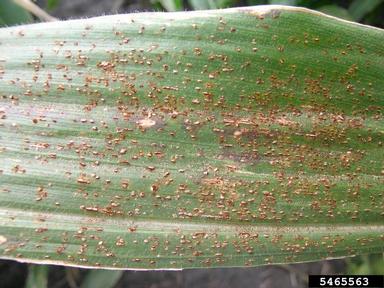
The most common corn rust is caused by the fungus Puccinia sorghi and usually appears after tasseling as dark, reddish-brown pustules on the upper and lower surfaces of the leaves. Infection is usually worst when temperatures are between 60° and 74°F and the relative humidity is high for an extended period of time. The rust fungus does not overwinter in the crop residue and new infections result from spores blown northward from warmer areas where the fungus survives on its alternate host, wood sorrel. Photo Credit Daren Mueller Wikimedia
Control:
- Remove infected plants immediately and dispose of them so that the spores of the fungus can not spread.
- Wash tools, hands, and clothing that may carry spores.
- Use resistant cultivars
- Water in the morning using drip irrigation to reduce the time that moisture is on the leaves
- Mulch plants to reduce the effects of rain splashing spores onto plants
- Increase air circulation by increasing space between plants or trimming excess foliage
- Spray with a solution of 1 tablespoon baking soda, 2 1/2 tablespoons vegetable oil, and 1 teaspoon of liquid soap (not detergent) per gal of water. Repeat every 2 weeks, more often if rain washes the solution away.
- Spray with a prepared solution of Bacillus subtilis about every 2 weeks or when rain has washed it off the leaves.
- For very severe infestations spray with copper or sulfur, heeding cautionary warnings on the containers. The copper application will require special equipment.